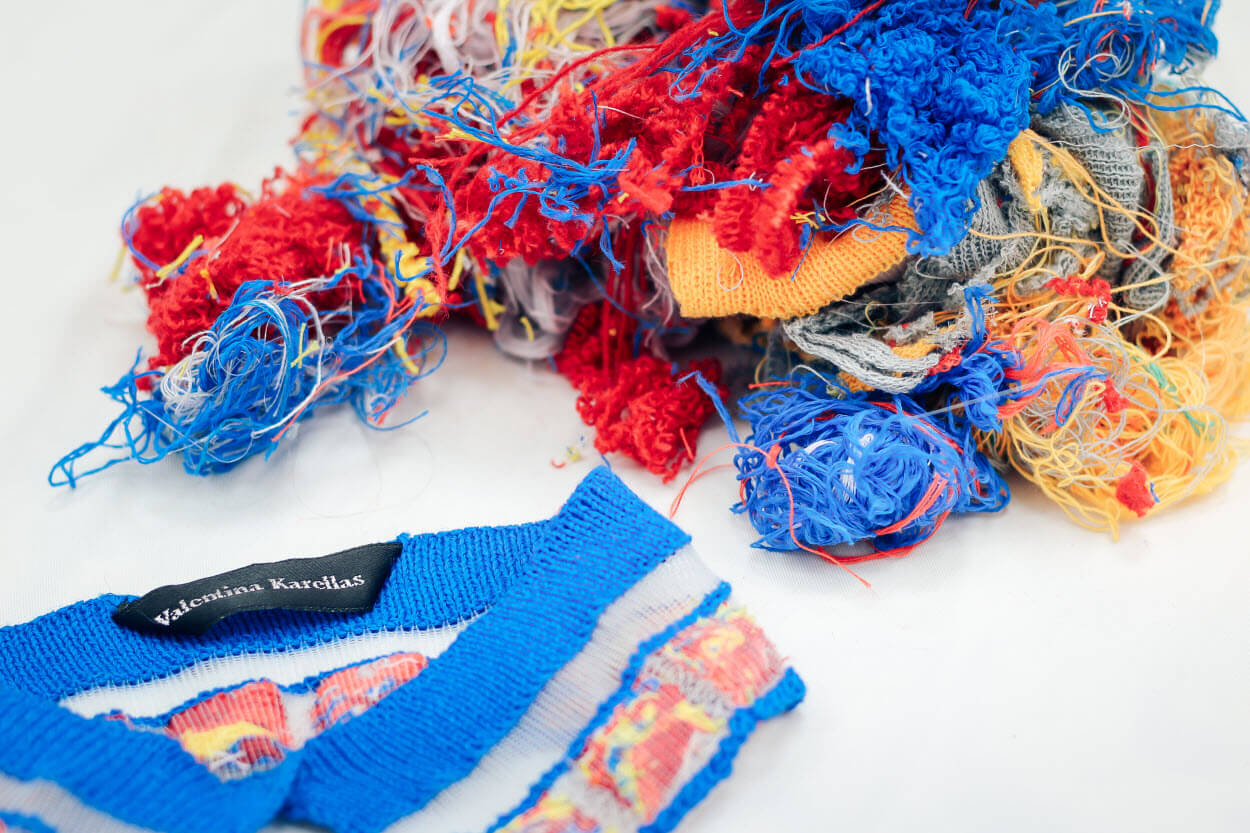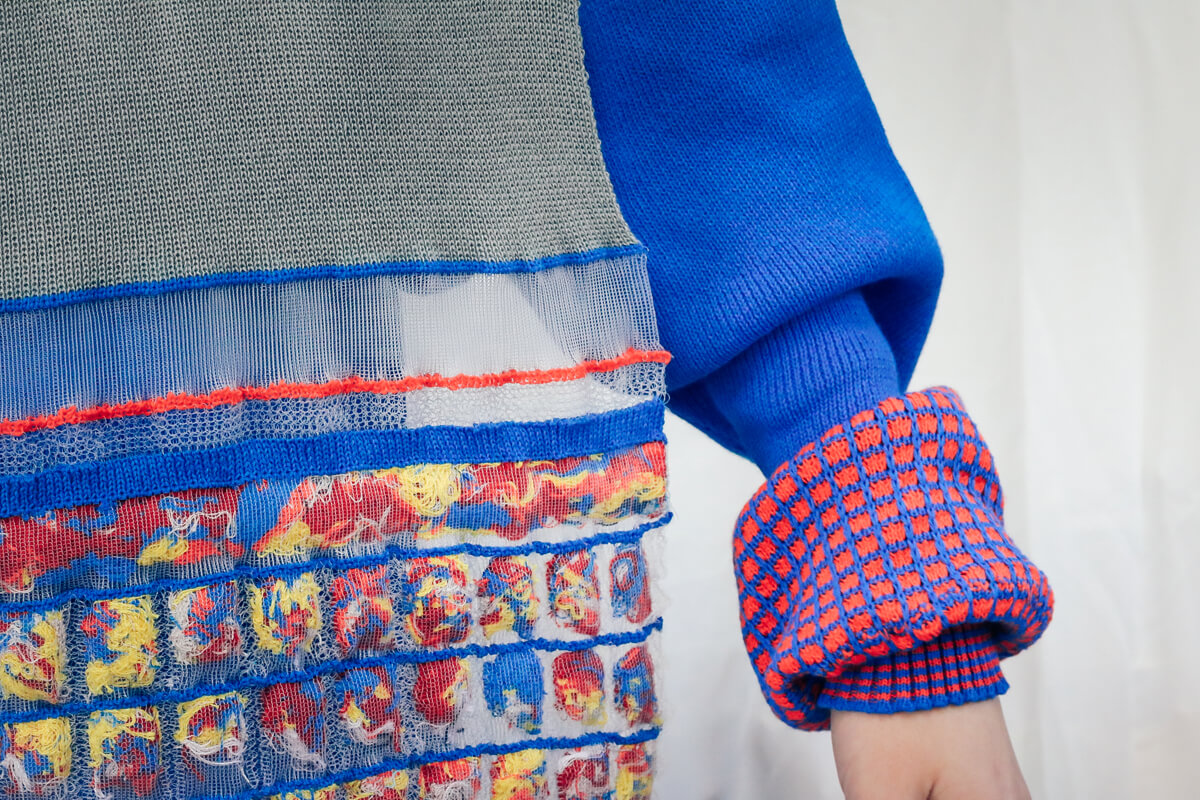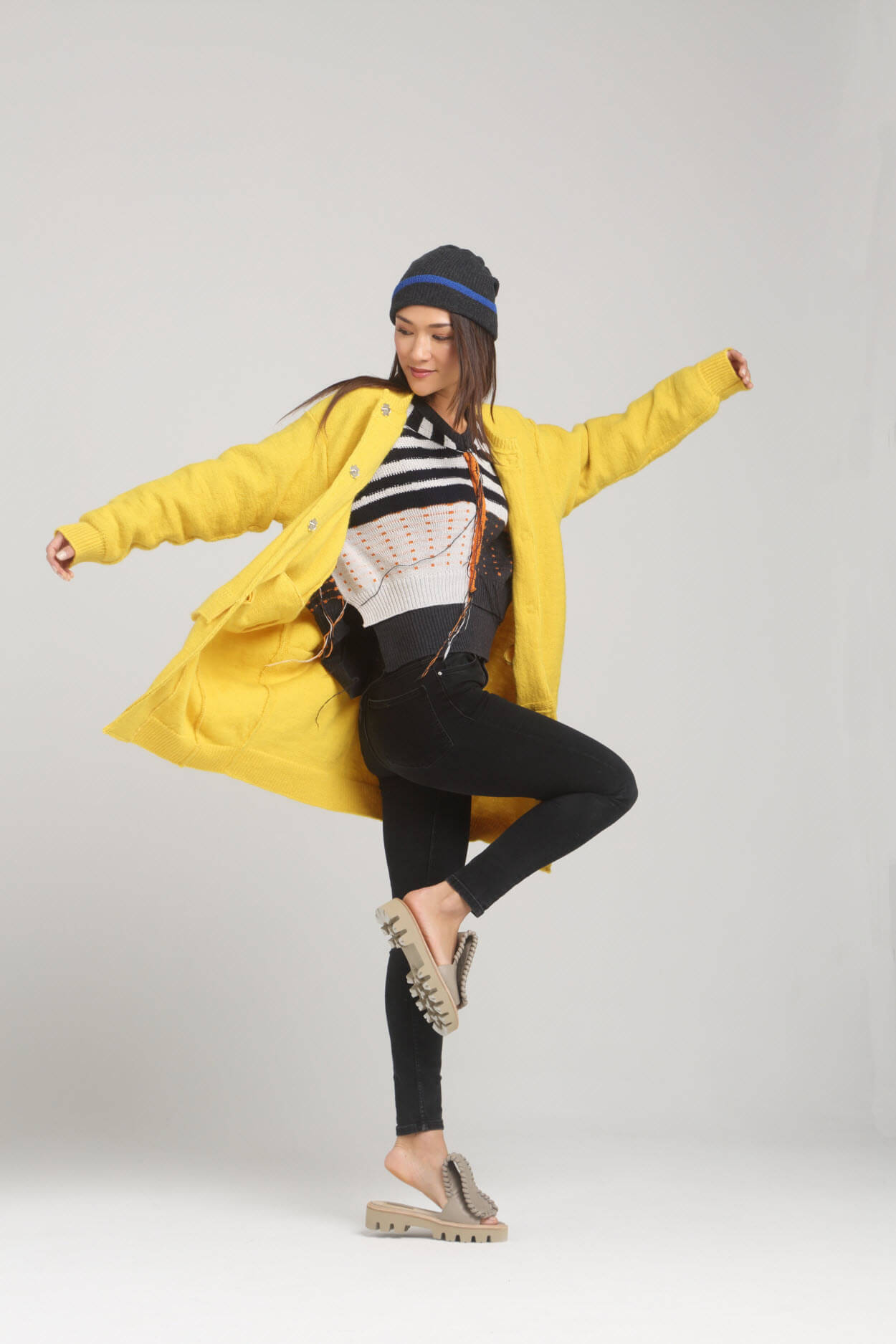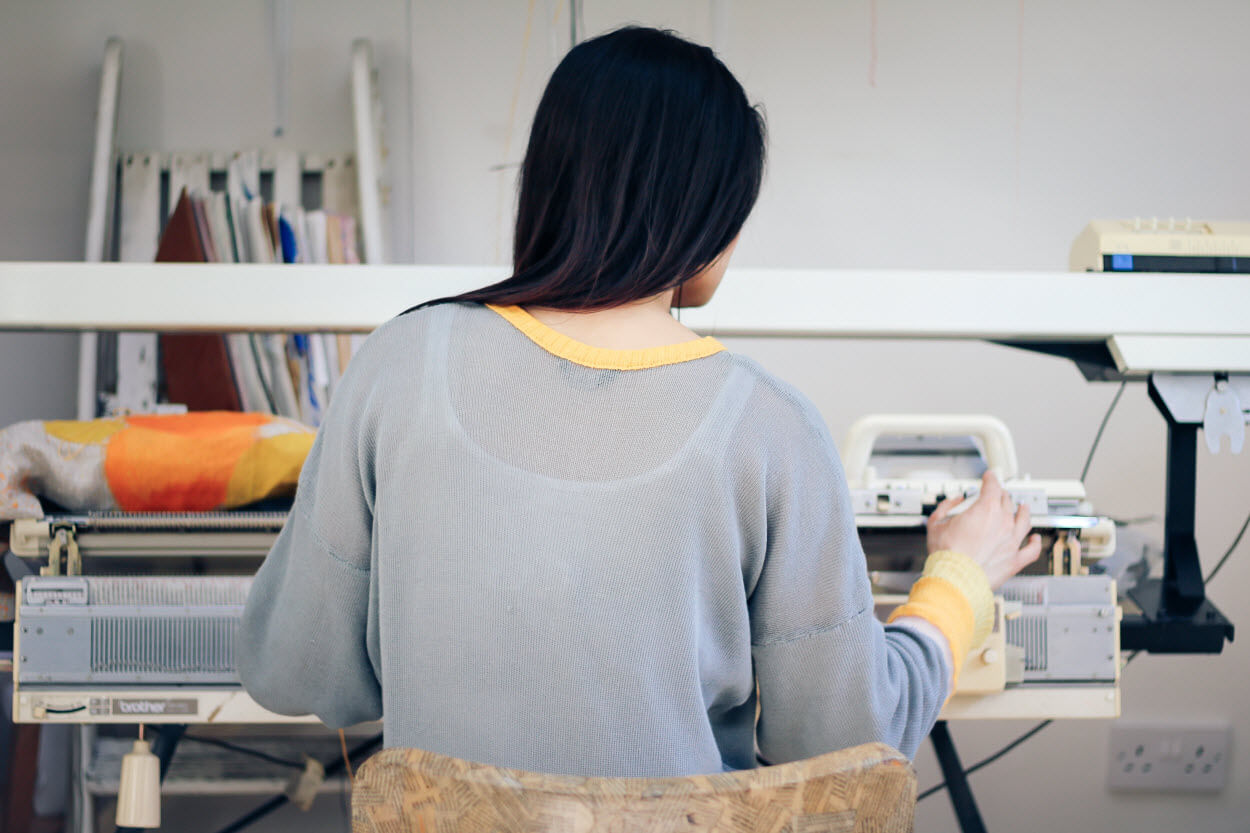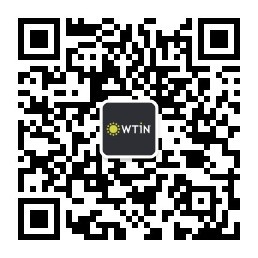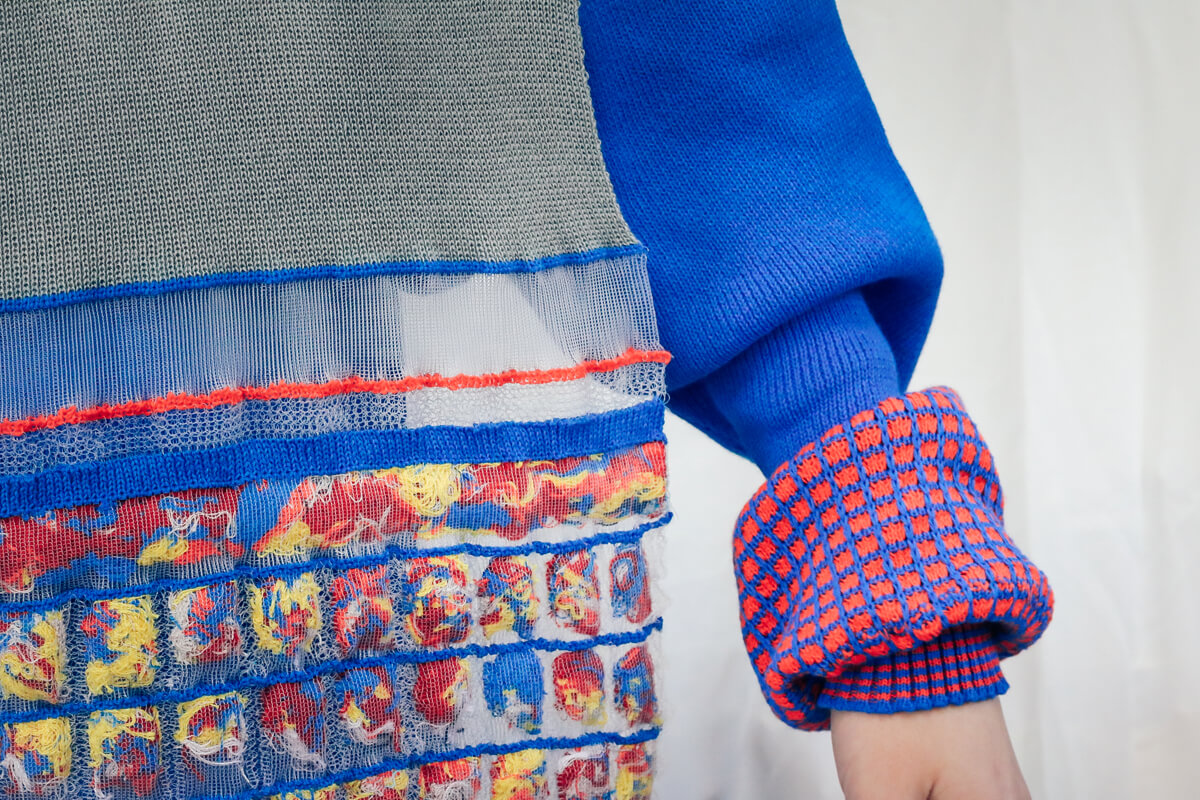
Valentina Karellas, founder of her eponymous label, tells Jessica Owen all about how working in fast fashion inspired her to create knitwear from surplus yarn.
“We shouldn’t be calling it ‘sustainable fashion’, it should just be fashion and should just be sustainable.” That is the view of Valentina Karellas, who has her own brand in north-west London.
Karellas studied knitwear design at the London College of Fashion and completed a master’s degree in womenswear design in Italy. She then began working in the industry, designing for different fashion houses for suppliers to fast-fashion retailers around the world.
On paper, Karellas had the dream job, but something didn’t sit right with her. “Fast fashion is not something you learn about at university and I didn’t know that it was a problem,” she says. “But after working in the industry, I could see the cost of it both environmentally and psychologically.”
“I would go to a factory and they would say, ‘We’ve just done this design, do you want to copy it?’ They had no respect for the contracts and it’s just stealing other people’s ideas.”
Even in the design studio, Karellas was asked to copy designs. “I wasn’t being challenged as a designer – they didn’t need a university master’s graduate; an intern can just copy someone else’s work.”
This experience with fast fashion is what inspired Karellas to create her own label. She wanted to get away from the constant churning out of clothes that were both morally and environmentally negative and get back into designing garments that would be both sustainable and treasured by people.
“Maybe I’ll make a difference and hopefully others will follow in their own way,” says Karellas.
Surplus yarn
Karellas launched her brand in August 2016 after five years of continuing to work in the industry while developing the company and saving for it.
Her brand is centred around creating knitwear garments that have been made from surplus yarn.
“I wanted to use surplus yarn. I didn’t want someone to create yarn for me, I didn’t want to add anymore waste.”
Karellas eventually found a supplier in the Midlands called Fairfield Yarns – a small, family-run business that buys yarn from factories that have no further use for it.
“I’m really pleased – it’s really good quality yarn and I’ve built a relationship with them and now they know what I like,” says Karellas. “I just ask him to send me yarn in a certain thickness and colour.”
In terms of fibres, Karellas tries to only work with natural fibres such as wool, cashmere and cotton. She’s asked for Tencel but often there is no surplus, and she’s also asked for organic cotton too, but she can’t advertise it as organic as the supplier does not have the original certification. Karellas does use surplus polypropylene sometimes to create a transparent look, she tried using silk, but it kept breaking due to its fragility.
At first, Karellas was quite apprehensive, worrying about having big orders and not having enough yarn. But to overcome this, she has a disclaimer on her website stating that if the yarn has finished, she will find something similar to work with.
“That way, people won’t have 50 million of the same products – everything will be slightly different and unique,” she says. “But so far, that hasn’t been a problem for me.”
In the beginning, Karellas says that she ‘went a bit crazy’ when ordering yarns and different colours and now she knows roughly how much to order per jumper.
“I won’t order anything below 1 kg – that way I know I can get about two to three garments from it,” says Karellas. “A jumper takes around 350 g, so my knowledge has grown a lot.”
And if you are thinking, ‘What happens to the surplus yarn from the knitwear made from surplus yarn?’, Karellas collects the excess and categorises it by colour and fibre. She then puts it back into her accessories or adds it in other ways.
“Sometimes that can be more fun than using it to create the main pieces, it’s quite simple really,” she says.
Machine knitting by hand
Originally, when Karellas decided to start her own brand, it was never going to be something she would make by herself.
The idea was to use London facilities, but it took a long time to source a factory and the only one she found worked with brands that put in hundreds or even thousands of orders.
“One day, I was sat waiting for a doctor’s appointment and while I was there, I realised that there was really only one option – I’m going to have to invest in myself and retrain in what I did at university.
“For the same money it would cost to make my first collection in a factory, it’s roughly the same as buying and investing in a machine. So I thought I would just do that. And that way, even if I end up making stuff in a factory at some point, it is always useful having the machines to play around with.”
Karellas uses the Industrial Dubied machine to create her garments. They were once used in all factories, but they are not as widely used anymore.
“It’s hand-powered so there’s no motor and it needs no electricity. My energy was cut off for about three weeks once and I could carry on working and it’s fantastic. If I need to use the steamer, then I use electricity for that, but it’s a really traditional way of knitting.”
‘Slow fashion’
Valentina Karellas is a multi-product brand. She creates jumpers, dresses, skirts, trousers and now she does a lot more accessories such as hats and scarves.
Although Karellas uses surplus yarn, this does not limit her when it comes to designs; in fact, it is the machine that limits the garments that can be made.
“I can’t do chunky knits as my machine is only a seven gauge and I can’t do too fine knits either,” she says. “I would love to do Jacquard, too, and other things like cables and anything lace, but they are so time consuming.
“But I have learnt about what the machine is good at and that’s ribbing and racking and a lot more.”
How long it takes to create a garment depends on the stitching involved. A garment with ribbing, wracking, tucking or ripples can take over a week to knit, however simpler pieces that just have rib and stripes can take a couple of days. What takes time is usually the washing, drying and linking time.
Karellas creates her garments on a made-to-order basis, so customers usually have to wait around three weeks to receive her pieces.
“People are used to ordering something and maybe even having it the same afternoon, so this helps to slow people down,” she says. “I want to reverse that thinking and that’s the whole idea of ‘slow fashion’, not having something on-demand and treasuring that piece.”
An uphill battle
There are several challenges that come with setting up your own business, and there are even harder challenges when trying to make the textile industry sustainable.
“I feel like it’s an uphill battle for people like me and other sustainable brands,” sys Karellas. “It is just so hard to get your voice out there and, even though people are now talking about sustainability, people are still not changing their shopping habits and that is the hardest challenge.”
Business-wise, funding has been the biggest issue. Karellas spent years working alongside planning for the company and has not got any investors and has not turned to crowd funding.
“Only after two years did I start making some income towards it, but anything I make just goes back into the business.
“At first, I started small and I just pulled in as many favours as I could, but I realised that the quality of work and the delivery that I was getting was quite slow and few and far between. That’s when I decided to invest a little bit more and you do get a return on your investment.”
Pop-ups and events
Karellas does not yet have her own retail space, instead she attends lots of trade fairs and different fashion pop-ups such as Handmade in Britain.
For the pop-ups, her and a few other designers all join in and have a shop in central London every few weeks. Here, she displays and sells her garments alongside others who might be selling bags and other clothing. Sometimes, she even hires out her own space, for example she had a spot recently in Brompton.
“It’s about that physical presence,” says Karellas. “It’s like when a band goes on tour – they go to different countries and they grow their network in that way. I grow my network one market or fair or shop at a time.”
In addition to having a sustainable brand, Karellas also wants to change the habits of consumers. So, she teaches workshops sometimes to teach people how to mend knitwear. The workshop is called the Visible Mending Workshop.
“Usually, if a person gets a hole in a garment, they throw that piece away. My way round that is teaching people simple techniques to show that hole in a new light, instead of hiding it with darning.
“I usually use bright colours and the repairs look really lovely. Hopefully this will encourage people to mend their clothes.”
Five-year plan
At the moment, Karellas has a small workshop in northwest London, but she has a five-year goal to create a WeWork space.
WeWork is an American company that was founded in 2010. The company provides shared spaces for entrepreneurs, freelancers, small businesses and so on to work together. Since then, this idea has spread, and it is a good way for people to bounce ideas off each other and work together.
“I want a WeWork-style space for knitting factories,” she says. “That would mean bringing in lots of creatives in one space, making my garments, whether they’re web developers or illustrators, and then they can also use the space for their own projects.”
“We could then branch out and have these little factories around the cities, so people in Liverpool don’t have to come all the way to London to work for a fashion house and have no hands-on, tangible experience.”
Karellas says it’s a big goal, but so is making the textile industry more sustainable. But with more and more people and companies popping up with innovative solutions, anything is possible.
Have your say. Join the conversation and follow us on LinkedIn


